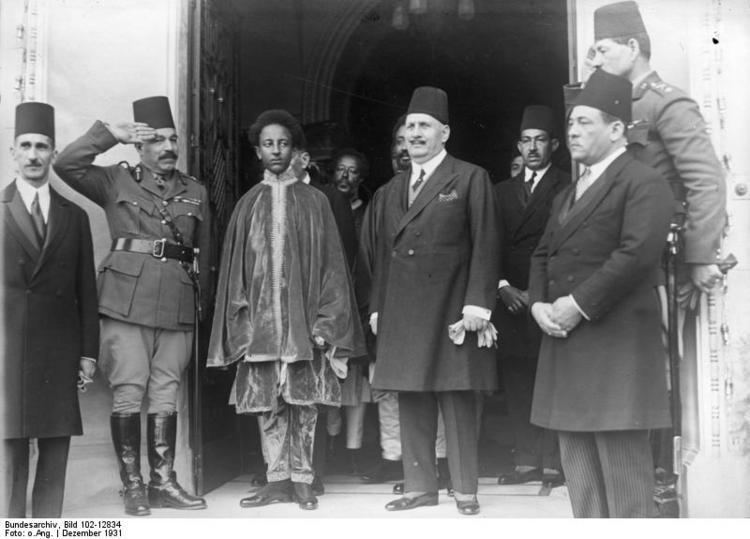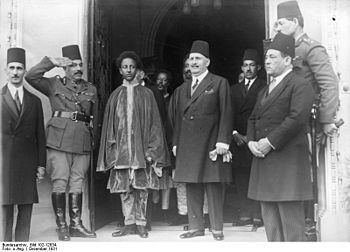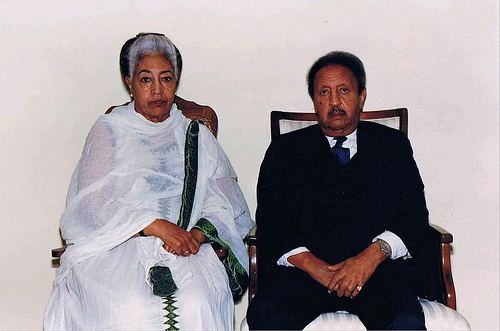Name Amha Selassie | ||
 | ||
Reign 12 September 1974 –12 March 1975 ChairmanDe facto Aman AndomTafari Benti Reign 8 April 1989 –17 February 1997 Parents Haile Selassie, Menen Asfaw Children Zera Yacob Amha Selassie Grandchildren Princess Lideta Zera Yacob Similar People Haile Selassie, Prince Makonnen, Menen Asfaw, Prince Sahle Selassie, Princess Tenagnework | ||
Amha selassie
Amha Selassie, GCMG, GCVO, GBE (27 July 1915 – 17 February 1997) was the last reigning monarch of Ethiopia. First proclaimed Emperor during the unsuccessful coup attempt by the Imperial Guards against his father Haile Selassie I in December 1960, he initially went along with this proclamation under duress. The coup collapsed within days and the Emperor Haile Selassie was restored. Amha Selassie was again proclaimed on the deposition of his father by the Derg on 12 September 1974, but he never accepted this proclamation as legitimate, and in any case this brief reign was ended with the abolition of the Ethiopian monarchy in March 1975. He was again proclaimed in exile on 8 April 1989. This time he sanctioned the proclamation and accepted its legitimacy.
Contents
- Amha selassie
- Empereor amha selassie of ethiopia p1
- Biography
- Short reign
- Life in exile
- Death
- Orders and decorations
- National
- Foreign
- Honorary military ranks
- References

He was born Asfaw Wossen Taffari, in the walled city of Harar, to Dejazmach Tafari Makonnen, then the governor of Harar and future Emperor of Ethiopia, and his wife Menen Asfaw, on 27 July 1916. After his accession his full reign name was His Imperial Majesty Emperor Amha Selassie I, Elect of God, Conquering Lion of the Tribe of Judah and King of Kings of Ethiopia.

Empereor amha selassie of ethiopia p1
Biography

Amha Selassie became Crown Prince Asfaw Wossen of Ethiopia when his father was crowned Emperor on 2 November 1930. Crown Prince Asfaw Wossen was granted the title of Meridazmach and the province (former kingdom) of Wollo to rule as his fief. He was married to Princess Wolete Israel Seyoum, great-granddaughter of Emperor Yohannis IV, and had a daughter, Princess Ijigayehu. Following the Italian invasion of Ethiopia in 1936, the Crown Prince and Princess went into exile with the rest of the Imperial family. They separated around 1938, and eventually divorced in 1941.

Following Emperor Haile Selassie's restoration in 1941, the Crown Prince returned to Ethiopia, and participated in the campaign to drive the Italian forces out of the city of Gondar, the last town they held in Ethiopia. He briefly served as acting governor of the provinces of Begemder and Tigray, retaining Wollo the entire time. He was eventually remarried to Princess Medferiashwork Abebe, and would father three more daughters, Princesses Mariam Senna, Sefrash, Sehin, and a son Prince Zera Yacob.
On the evening of 13 December 1960, the commander of the Imperial Guard, Mengistu Neway, with his brother Germame Neway launched a coup d'état and seized power in Ethiopia while the Emperor was on a visit to Brazil. The coup leaders detained Crown Prince Asfaw Wossen in the Imperial Palace, and the following morning, having secured control over most of the capital, then compelled the Crown Prince to read a radio statement, in which he accepted the crown in his father's place and announced a government of reform. However, the regular Army, led by Dejazmach Asrate Medhin Kassa and Chief of Staff, Major General Mared Mangesha, spent the following day gaining control of other military formations, as well as the Air Force; later that day Patriarch Abuna Basilios of the Ethiopian Orthodox Church, issued an anathema against all those who cooperated with the rebels. On 15 December fighting broke out in the city, and the rebels were driven out of Addis Ababa; before retreating the rebels slaughtered many members of the government and the nobility held hostage in the Green Salon of the palace. Among the dead were Abebe Aregai and Seyum Mangasha. The Emperor returned to Ethiopia, entering the capital on 17 December. Although it was explained that the Crown Prince had acted under duress, his outlook had long been regarded as considerably more liberal than that of his father, and so he would always be suspected of having been a willing participant in the coup attempt. By contrast, Medferiashwork Abebe, the wife of the Crown Prince, is credited with playing a role against the coup attempt.
In 1973, Crown Prince Asfaw Wossen suffered a massive stroke and was evacuated to Switzerland for medical treatment. He was accompanied by his wife and daughters. The stroke left him permanently unable to walk, paralyzed on one side, and affected his speech. As Prince Asfaw Wossen was not expected to live, his son, Prince Zera Yacob, a student at Oxford at the time, was named "Acting Crown Prince" and "Heir Presumptive".
Short reign
The so-called "short reign" of Amha Selassie in 1974 was in name only between the deposition of his father on 12 September 1974 until the abolition of the monarchy in the March 1975.
Haile Selassie I never signed an abdication, nor did he renounce his rights. The military junta declared the Crown Prince "King" instead of "Emperor", but he never acknowledged the title nor accepted his father's dethronement. When the new government massacred 61 ex-officials of the Imperial government, Crown Prince Asfaw Wossen issued a strong denunciation that was broadcast on the BBC. The statement was issued in the name of "Crown Prince Asfaw Wossen" which indicated that he was refusing to recognize the Derg's declaration of him as monarch in his father's place. He continued to use the title of Crown Prince during his exile until April 1989 when he finally assumed the title of Emperor with the reign name of Amha Selassie I. His succession was back-dated, not to September 1974 when his father was deposed, but to August 1975 when Emperor Haile Selassie died. He thus confirmed his refusal to regard any of the acts carried out by the Derg regime as legitimate or legal.
Life in exile
On 12 September 1974, the Derg military junta deposed Emperor Haile Selassie and declared that Crown Prince Asfaw Wossen would be anointed "King" upon his return from medical treatment in Geneva, Switzerland. It intended for Asfaw to rule as a constitutional monarch.
However, the Prince did not recognize this proclamation and did not return to Ethiopia. When instead he announced to the Ethiopian Embassy in London that he would be moving to that city shortly, the Embassy asked the Derg for instructions as to whether it should receive him as King and head-of-state, or if it should receive him as Crown Prince upon his arrival in the United Kingdom. The Derg replied that he should be received as a simple citizen of Ethiopia and that no royal dignities were to be accorded to the Prince or his family. The revolutionaries soon abolished the monarchy in March 1975, and Crown Prince Asfaw Wossen settled permanently in London, where several other members of the Imperial family were already based. The other members of the Imperial family who were still in Ethiopia at the time of the revolution were imprisoned, including Asfaw Wossen's father the Emperor, his daughter by his first marriage, Princess Ijigayehu, his sister Princess Tenagnework and many of his nephews, nieces, relatives and in-laws. In 1975, first his father Emperor Haile Selassie and then in January 1977, his daughter Princess Ijigayehu died in detention. Members of the Imperial family remained imprisoned until 1988 (for the women) and 1989 (for the men).
In April 1989, Crown Prince Asfaw Wossen was proclaimed "Emperor of Ethiopia" in exile, at his home in London by members of the exiled Ethiopian community. He took the throne name of Amha Selassie I. His wife began also using the title of "Empress". A year later, the Emperor and Empress in exile moved to McLean, Virginia, USA to be close to the large Ethiopian immigrant population in and around Washington, D.C.
In 1991, with the fall of the Derg, and the coming to power of the EPRDF in Ethiopia, Amha Selassie founded the Moa Anbessa Monarchist Movement to promote a monarchial restoration in Ethiopia and announced his intention to return to his country for a visit. However, following the disinterment of the remains of Emperor Haile Selassie, a dispute erupted between the Imperial family and the new government over the status of a funeral that was planned for the late Emperor. The government refused to give Haile Selassie a state funeral, and as a result, the funeral, and the return of Amha Selassie was indefinitely postponed.
Death
Amha Selassie died at the age of 81 on 17 February 1997, after long illnesses, in the US state of Virginia. He had never completely recovered from the massive stroke he experienced in 1973. His body was flown back to Ethiopia and buried in the Imperial family vaults at Holy Trinity Cathedral in Addis Ababa in a huge ceremonial funeral presided over by Patriarch Abune Paulos.
Orders and decorations
Amha Selassie was awarded numerous honours, including:
National
Foreign
Honorary military ranks
Amha Selassie held the following military ranks:
